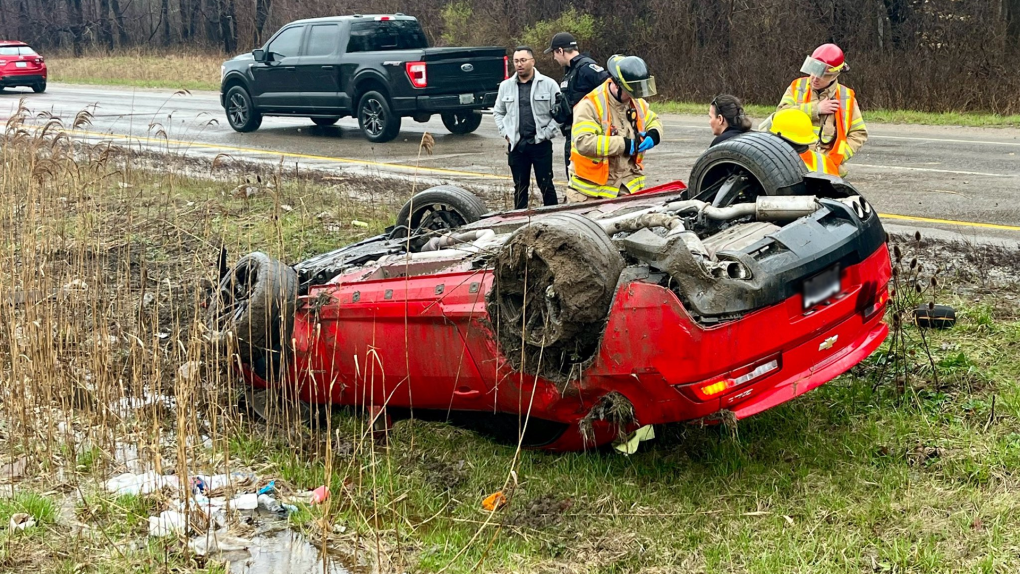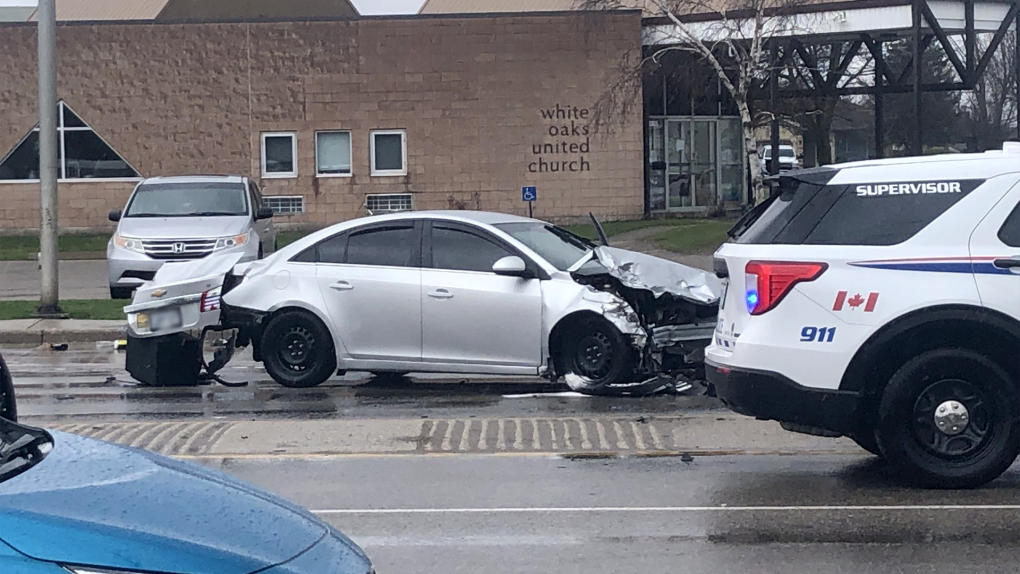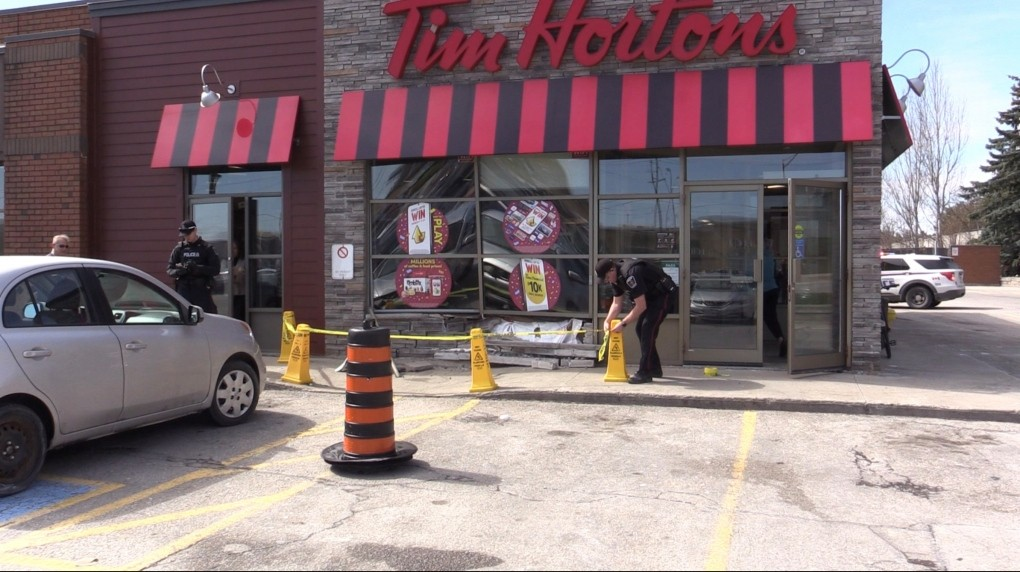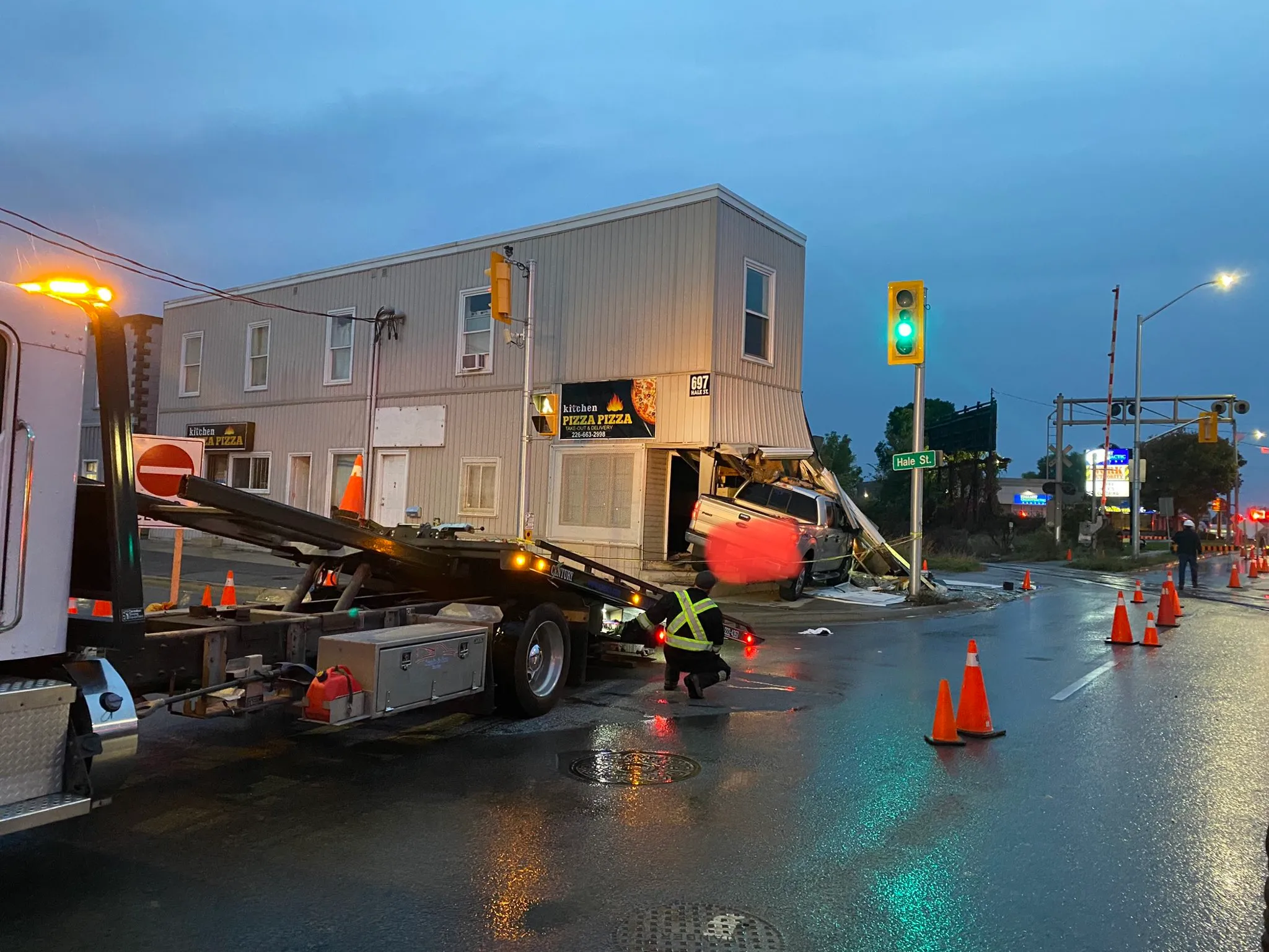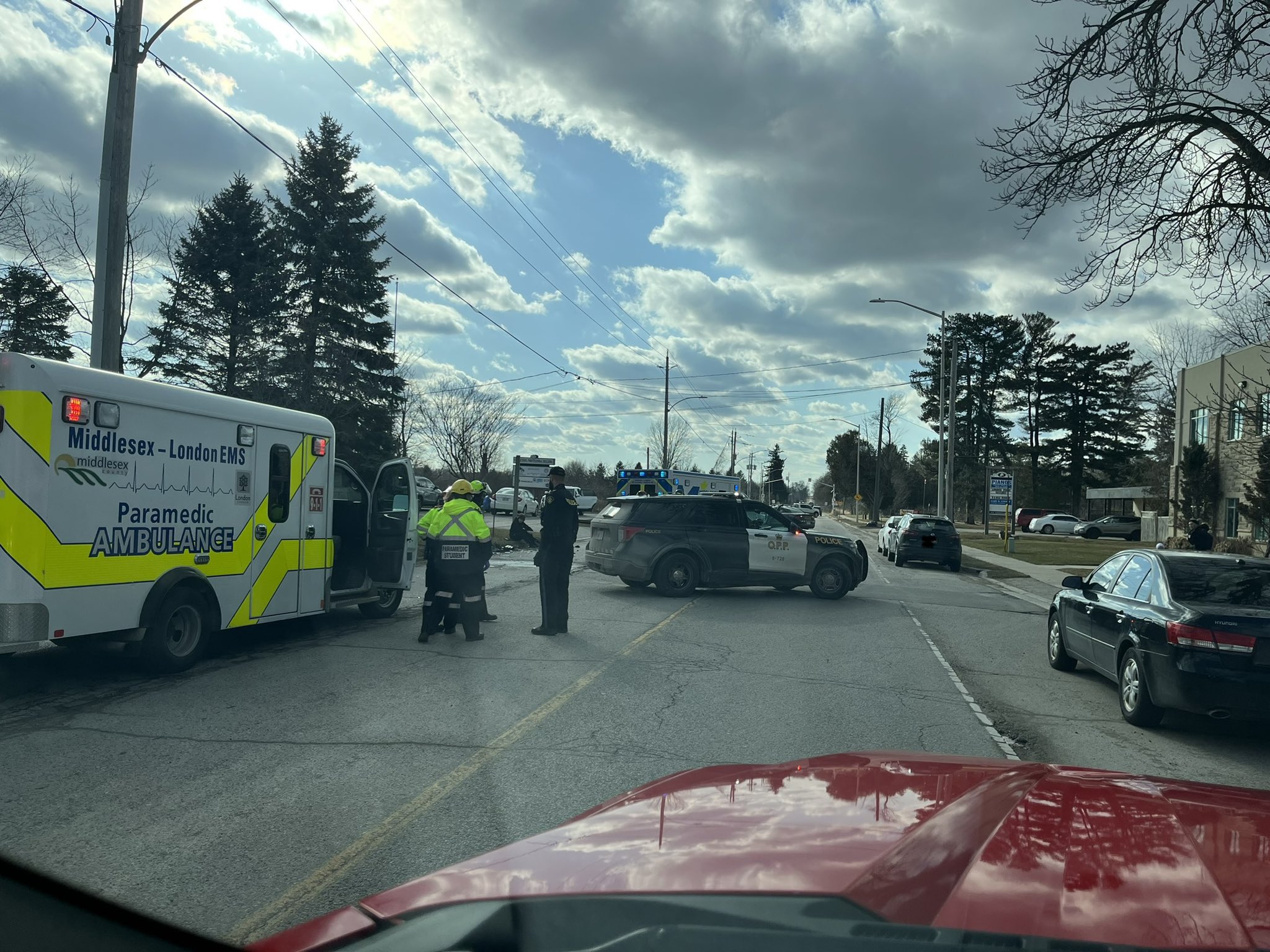Many involved in highway drama
Diary of truck crash: 10:25 p.m., May 16
At 10:24 p.m., Friday, Muhammad Ali and Ron Lyle were waltzing in a Las Vegas boxing ring, attendants at Thames Valley Ambulance in London were watching on their color television set, fire fighters at the central firehall were settling in for another overnight shift, and Bill Jensen and Allen Davey were about to meet.
Mr. Davey, a 34-year-old trucker from Brampton, had just left London after picking up a load of scrap paper from Labatt’s brewery.
Now, with his companion, 24-year-old Russ Dickie, also of Brampton, Mr. Davey was wheeling his flatbed tractor-trailer off an access ramp near Wellington Road and into the eastbound lane of Highway 401.
They were headed home.
At the same moment, Bill Jensen was near the end of one of his last runs as a truck driver.
The 39-year-old Brownsville man was giving up the driving game after this year. His wife, Ruth, worried about his safety.
Mr. Jensen was bound for Ingersoll, his transport singing along the eastbound lane of Highway 401, loaded with lawn mower shrouds.
At 10:25 p.m., moments after Mr. Davey’s truck entered the traffic lane, seconds after Mr. Jensen’s rig cleared the Wellington Road overpass, the trucks collided.
The crash reduced the $35,000 tractor of the Jensen truck to scrap metal. The impact drove the hot diesel engine to the rear of the cab near the ruptured fuel tanks.
As the cab caved in, Mr. Jensen pitched forward, his legs trapped by the buckled dashboard, pinned by a mass of metal that had been the truck’s floor, body metal, clutch pedal and steering wheel.
Both legs broken like kindling, Mr. Jensen hung limply from the smoking wreckage.
Mr. Davey and Mr. Dickie fared better. Tossed about in their cab like ping pong balls by the force of the crash, Mr. Dickie emerged with a slice across the crown of his head. Mr. Davey scrambled out with an immobilized right arm.
The collision had disintegrated a rear corner of their trailer, broken its frame and shifted a load of baled scrap paper eight feet backward.
Private Whanita Westrop, standing on the shoulder of the westbound lanes, saw the crash.
A member of the Canadian Armed Forces stationed at CFB Borden, she had been trying to hitch a ride to Windsor.
When she saw Mr. Jensen’s cab fold up, she darted across the highway to try to help the injured man, she recalled later.
Officers at the nearby provincial police detachment leapt to windows to see what had caused “that terrific crash.”
At 10:27 p.m., the telephone rang at Thames Valley Ambulance. It was the OPP reporting the accident and requesting an ambulance. Dispatcher Peter Allen sent attendants Bob Duffield and Bill MacGregor.
While they were threading their way south on Wellington Road, OPP Constable Gary Berdan and radio operator Wayne Delaney arrived at the crash site.
Mr. Delaney took a first-aid kit from the rear of the cruiser and bandaged Mr. Dickie’s scalp. Constable Berdan began his investigation.
It was going to mean a lot of paperwork.
Mr. Davey’s flatbed was standing in the slow lane; Mr. Jensen’s was sprawled across the passing lane with the tractor in the median.
Pte. Westrop was in front of Mr. Jensen’s wrecked tractor, holding the injured man’s head up and trying to soothe him.
Mr. Jensen wanted to get out of the cab, she recalled, but she could see he was hopelessly pinned and urged him not to move.
She frequently interrupted her attempts to comfort Mr. Jensen to warn off the first of a growing crowd of spectators.
“Put that cigarette out,” she ordered many – the median ditch was slowly filling with diesel oil.
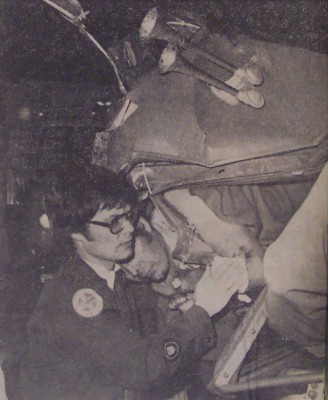
Thames Valley Ambulance attendant Bill MacGregor comforts injured trucker Bill Jensen of Brownsville as firefighters work to cut the man from his crushed transport cab on Highway 401 near Wellington Road late Friday. Mr. MacGregor supported the conscious driver for more than an hour.
(Mike Jordan – The London Free Press)
At 10:33 p.m., the ambulance arrived. A minute later, the phone rang again at the Thames Valley office.
The fire department dispatcher said the department’s emergency squad had been requested and was on its way.
TVA supervisor Jim Carney and attendant Jon Marshall left for Victoria Hospital to pick up intravenous (IV) equipment and a doctor to administer the medication.
When they arrived at the hospital, the IV apparatus was ready but there wasn’t a doctor available who could leave the hospital.
Mr. Carney phoned Dr. Ali Abbasakoor due on duty at 11 p.m. The doctor was willing to go with them but he was at his home in Byron, too far in the wrong direction for the ambulance to pick him up.
“I told him: ‘There’ll be a police car at your front door in two minutes’, and I called the cops and left for the highway,” Mr. Carney recalled.
He arrived at 10:56 p.m., about 20 minutes after the first ambulance.
The IV equipment was set up on a stretcher and rolled over to the crushed cab.
Mr. MacGregor was holding Mr. Jensen’s upper body on a level plane with a small fracture board. He talked to him, trying to keep the injured man’s spirits up and watching for changes in vital signs.
Mr. Duffield was concentrating on saving the man’s legs while firefighters worked to cut the cab open.
Mr. Carney turned the IV equipment over to Mr. Duffield just as a city police cruiser arrived with Dr. Abbasakoor, who would administer the medication, a solution of dextrose and water to help prevent shock.
Then Mr. Carney and his partner, Mr. Marshall, helped firefighters cut open the wreck.
Platoon chief Ed Purcell and nine firefighters were at the scene for almost two hours.
Included in their number was Capt. Ken Candy, head of the emergency squads and the operators of a pumper and a tanker.
The four-man emergency squad worked on the wreck with power saws and hydraulic jacks, impact chisels, crowbars and chains.
While some turned their saw blades red hot trying to cut through the thick body metal, others sprayed the blades with hoses to prevent the heat or sparks from touching off the pools of diesel fuel.
At 11:11 p.m., TVA attendants Al Cook and Mike Catton were dispatched to Victoria Hospital to pick up Dr. Don Nagle, who was taking morphine and other drugs to the scene.
When they arrived at the crowded crash site, Mr. Catton went to Mr. Jensen’s truck to assist in the removal operation while Mr. Cook attended to the other truckers’ injuries.
Mr. Cook found that Mr. Dickie, the passenger, was beginning to bleed through the bandage applied by the OPP radio
operator. After putting more bandages on the man’s head, Mr. Cook put Mr. Davey’s arm in a sling – the trucker had been complaining of what seemed to be a broken collarbone.
Then, for another hour, there was nothing to do but wait while firefighters continued cutting, hacking, pulling at the stubborn metal; while doctors and ambulance attendants continued treating Mr. Jensen, trying to ease pressure on his legs to keep the circulation going, trying to save his legs.
And while the rescuers worked, the gawkers gathered.
Onlookers parked their cars as close to the accident as possible, then walked across fields for a better look.
Sightseers wandered in front of eastbound traffic, which was being diverted around the wreck along the south shoulder of the highway.
OPP officers and auxiliary members of the force and city police couldn’t hold back the waves of spectators.
With each shouted order, the gawkers would recede then sweep back almost immediately.
At midnight, firefighters attached a cable to the base of Mr. Jensen’s seat and anchored it to a set of wheels on his twisted trailer.
Another line was fastened around the truck’s steering wheel to the nearest vehicle, an ambulance.
Using the ambulance as a tow truck, the rescuers began pulling on the front of the cab. The wreckage opened up like a new rose.
At 12:10 a.m., Saturday, Mr. Jensen was pulled from the wreck, placed on a stretcher and taken to Victoria Hospital.
It was over.
Incredibly, his injuries were limited to broken legs and some cuts.
Sunday night, Mr. Jensen was resting at Victoria Hospital, cheerful and in fair condition, the nurses said.
Trucker Davey had been in for treatment shortly after Mr. Jensen arrived but was released early Saturday.
Constable Gary Berdan began trying to put the pieces together.
It might be several days, he said before he knew for sure the cause of the accident and who, if anyone was at fault.
By 4 a.m., Saturday, the wreckage had been cleared and there was little to mark the site of the drama – except a bale of scrap paper that had tumbled from the Davey truck.
On the bottom of the bale was a piece of cardboard bearing the words “do not litter.”
Pte. Westrop, pushed to the sidelines once the rescuers arrived, got to Windsor.
“Laidlaw’s Transport Ltd. (Mr. Jensen’s employer) saw to that,” Constable Berdan said.
Many involved in highway drama
Diary of truck crash: 10:25 p.m., May 16
At 10:24 p.m., Friday, Muhammad Ali and Ron Lyle were waltzing in a Las Vegas boxing ring, attendants at Thames Valley Ambulance in London were watching on their color television set, fire fighters at the central firehall were settling in for another overnight shift, and Bill Jensen and Allen Davey were about to meet.
Mr. Davey, a 34-year-old trucker from Brampton, had just left London after picking up a load of scrap paper from Labatt’s brewery.
Now, with his companion, 24-year-old Russ Dickie, also of Brampton, Mr. Davey was wheeling his flatbed tractor-trailer off an access ramp near Wellington Road and into the eastbound lane of Highway 401.
They were headed home.
At the same moment, Bill Jensen was near the end of one of his last runs as a truck driver.
The 39-year-old Brownsville man was giving up the driving game after this year. His wife, Ruth, worried about his safety.
Mr. Jensen was bound for Ingersoll, his transport singing along the eastbound lane of Highway 401, loaded with lawn mower shrouds.
At 10:25 p.m., moments after Mr. Davey’s truck entered the traffic lane, seconds after Mr. Jensen’s rig cleared the Wellington Road overpass, the trucks collided.
The crash reduced the $35,000 tractor of the Jensen truck to scrap metal. The impact drove the hot diesel engine to the rear of the cab near the ruptured fuel tanks.
As the cab caved in, Mr. Jensen pitched forward, his legs trapped by the buckled dashboard, pinned by a mass of metal that had been the truck’s floor, body metal, clutch pedal and steering wheel.
Both legs broken like kindling, Mr. Jensen hung limply from the smoking wreckage.
Mr. Davey and Mr. Dickie fared better. Tossed about in their cab like ping pong balls by the force of the crash, Mr. Dickie emerged with a slice across the crown of his head. Mr. Davey scrambled out with an immobilized right arm.
The collision had disintegrated a rear corner of their trailer, broken its frame and shifted a load of baled scrap paper eight feet backward.
Private Whanita Westrop, standing on the shoulder of the westbound lanes, saw the crash.
A member of the Canadian Armed Forces stationed at CFB Borden, she had been trying to hitch a ride to Windsor.
When she saw Mr. Jensen’s cab fold up, she darted across the highway to try to help the injured man, she recalled later.
Officers at the nearby provincial police detachment leapt to windows to see what had caused “that terrific crash.”
At 10:27 p.m., the telephone rang at Thames Valley Ambulance. It was the OPP reporting the accident and requesting an ambulance. Dispatcher Peter Allen sent attendants Bob Duffield and Bill MacGregor.
While they were threading their way south on Wellington Road, OPP Constable Gary Berdan and radio operator Wayne Delaney arrived at the crash site.
Mr. Delaney took a first-aid kit from the rear of the cruiser and bandaged Mr. Dickie’s scalp. Constable Berdan began his investigation.
It was going to mean a lot of paperwork.
Mr. Davey’s flatbed was standing in the slow lane; Mr. Jensen’s was sprawled across the passing lane with the tractor in the median.
Pte. Westrop was in front of Mr. Jensen’s wrecked tractor, holding the injured man’s head up and trying to soothe him.
Mr. Jensen wanted to get out of the cab, she recalled, but she could see he was hopelessly pinned and urged him not to move.
She frequently interrupted her attempts to comfort Mr. Jensen to warn off the first of a growing crowd of spectators.
“Put that cigarette out,” she ordered many – the median ditch was slowly filling with diesel oil.

Thames Valley Ambulance attendant Bill MacGregor comforts injured trucker Bill Jensen of Brownsville as firefighters work to cut the man from his crushed transport cab on Highway 401 near Wellington Road late Friday. Mr. MacGregor supported the conscious driver for more than an hour.
(Mike Jordan – The London Free Press)
At 10:33 p.m., the ambulance arrived. A minute later, the phone rang again at the Thames Valley office.
The fire department dispatcher said the department’s emergency squad had been requested and was on its way.
TVA supervisor Jim Carney and attendant Jon Marshall left for Victoria Hospital to pick up intravenous (IV) equipment and a doctor to administer the medication.
When they arrived at the hospital, the IV apparatus was ready but there wasn’t a doctor available who could leave the hospital.
Mr. Carney phoned Dr. Ali Abbasakoor due on duty at 11 p.m. The doctor was willing to go with them but he was at his home in Byron, too far in the wrong direction for the ambulance to pick him up.
“I told him: ‘There’ll be a police car at your front door in two minutes’, and I called the cops and left for the highway,” Mr. Carney recalled.
He arrived at 10:56 p.m., about 20 minutes after the first ambulance.
The IV equipment was set up on a stretcher and rolled over to the crushed cab.
Mr. MacGregor was holding Mr. Jensen’s upper body on a level plane with a small fracture board. He talked to him, trying to keep the injured man’s spirits up and watching for changes in vital signs.
Mr. Duffield was concentrating on saving the man’s legs while firefighters worked to cut the cab open.
Mr. Carney turned the IV equipment over to Mr. Duffield just as a city police cruiser arrived with Dr. Abbasakoor, who would administer the medication, a solution of dextrose and water to help prevent shock.
Then Mr. Carney and his partner, Mr. Marshall, helped firefighters cut open the wreck.
Platoon chief Ed Purcell and nine firefighters were at the scene for almost two hours.
Included in their number was Capt. Ken Candy, head of the emergency squads and the operators of a pumper and a tanker.
The four-man emergency squad worked on the wreck with power saws and hydraulic jacks, impact chisels, crowbars and chains.
While some turned their saw blades red hot trying to cut through the thick body metal, others sprayed the blades with hoses to prevent the heat or sparks from touching off the pools of diesel fuel.
At 11:11 p.m., TVA attendants Al Cook and Mike Catton were dispatched to Victoria Hospital to pick up Dr. Don Nagle, who was taking morphine and other drugs to the scene.
When they arrived at the crowded crash site, Mr. Catton went to Mr. Jensen’s truck to assist in the removal operation while Mr. Cook attended to the other truckers’ injuries.
Mr. Cook found that Mr. Dickie, the passenger, was beginning to bleed through the bandage applied by the OPP radio
operator. After putting more bandages on the man’s head, Mr. Cook put Mr. Davey’s arm in a sling – the trucker had been complaining of what seemed to be a broken collarbone.
Then, for another hour, there was nothing to do but wait while firefighters continued cutting, hacking, pulling at the stubborn metal; while doctors and ambulance attendants continued treating Mr. Jensen, trying to ease pressure on his legs to keep the circulation going, trying to save his legs.
And while the rescuers worked, the gawkers gathered.
Onlookers parked their cars as close to the accident as possible, then walked across fields for a better look.
Sightseers wandered in front of eastbound traffic, which was being diverted around the wreck along the south shoulder of the highway.
OPP officers and auxiliary members of the force and city police couldn’t hold back the waves of spectators.
With each shouted order, the gawkers would recede then sweep back almost immediately.
At midnight, firefighters attached a cable to the base of Mr. Jensen’s seat and anchored it to a set of wheels on his twisted trailer.
Another line was fastened around the truck’s steering wheel to the nearest vehicle, an ambulance.
Using the ambulance as a tow truck, the rescuers began pulling on the front of the cab. The wreckage opened up like a new rose.
At 12:10 a.m., Saturday, Mr. Jensen was pulled from the wreck, placed on a stretcher and taken to Victoria Hospital.
It was over.
Incredibly, his injuries were limited to broken legs and some cuts.
Sunday night, Mr. Jensen was resting at Victoria Hospital, cheerful and in fair condition, the nurses said.
Trucker Davey had been in for treatment shortly after Mr. Jensen arrived but was released early Saturday.
Constable Gary Berdan began trying to put the pieces together.
It might be several days, he said before he knew for sure the cause of the accident and who, if anyone was at fault.
By 4 a.m., Saturday, the wreckage had been cleared and there was little to mark the site of the drama – except a bale of scrap paper that had tumbled from the Davey truck.
On the bottom of the bale was a piece of cardboard bearing the words “do not litter.”
Pte. Westrop, pushed to the sidelines once the rescuers arrived, got to Windsor.
“Laidlaw’s Transport Ltd. (Mr. Jensen’s employer) saw to that,” Constable Berdan said.

